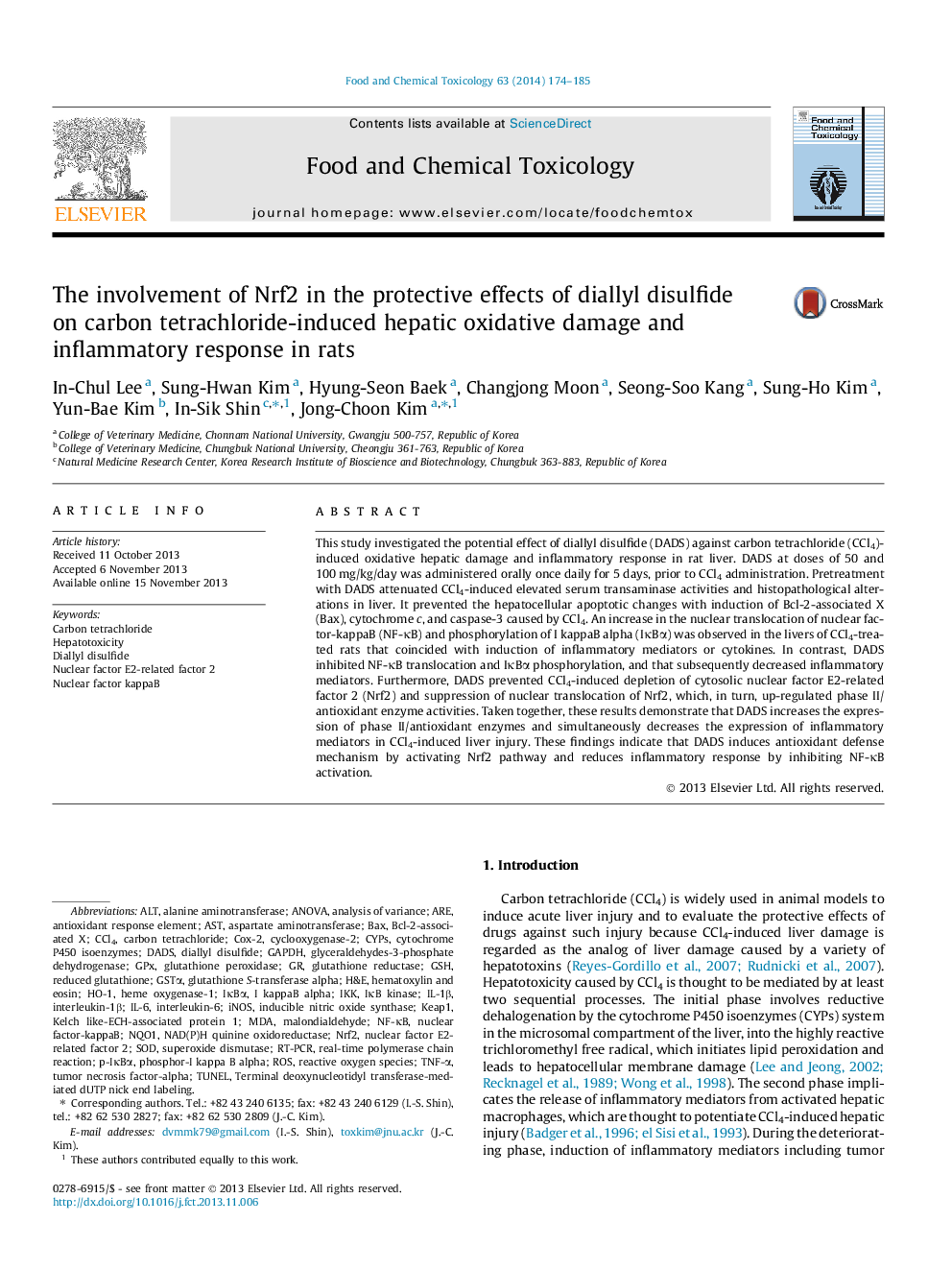| کد مقاله | کد نشریه | سال انتشار | مقاله انگلیسی | نسخه تمام متن |
|---|---|---|---|---|
| 5850837 | 1561781 | 2014 | 12 صفحه PDF | دانلود رایگان |
عنوان انگلیسی مقاله ISI
The involvement of Nrf2 in the protective effects of diallyl disulfide on carbon tetrachloride-induced hepatic oxidative damage and inflammatory response in rats
دانلود مقاله + سفارش ترجمه
دانلود مقاله ISI انگلیسی
رایگان برای ایرانیان
کلمات کلیدی
IKKGSHGPXGAPDHHO-1COX-2RT-PCRALTCCl4IL-1βiNOSHeme oxygenase-1IκBαNQO1DADSkelch like-ECH-associated protein 1Bcl-2-associated XCytochrome P450 isoenzymesMDANrf2NF-κBIL-6keap1 - buy1CYPs - CYPH&E - H & EIκB kinase - IkB kinaseROS - ROSAST - آسپارتات ترانس آمینازAspartate aminotransferase - آسپارتات ترانس آمیناز یا AST Alanine aminotransferase - آلانین آمینوترانسفرازinterleukin-6 - اینترلوکین ۶Interleukin-1β - اینترلوکین-1βBax - باکسanalysis of variance - تحلیل واریانسANOVA - تحلیل واریانس Analysis of varianceTerminal deoxynucleotidyl transferase-mediated dUTP nick end labeling - ترمینال deoxynucleotidyl transferase-mediated dUTP نام نهایی پایان نامهtumor necrosis factor-alpha - تومور نکروز عامل آلفاTUNEL - تونلDiallyl disulfide - دی سولفید دیالیلSOD - سدHepatotoxicity - سمیت کبدinducible nitric oxide synthase - سنتاز اکسید نیتریک القاییSuperoxide dismutase - سوکسوکس دیسموتازCyclooxygenase-2 - سیکلوکوکسیژناز2nuclear factor E2-related factor 2 - عامل فاکتور هسته ای E2 عامل 2antioxidant response element - عنصر پاسخ آنتی اکسیدانTNF-α - فاکتور نکروز توموری آلفاnuclear factor-kappaB - فاکتور هسته ای - kappaBnuclear factor kappaB - فاکتور هسته ای kappaBmalondialdehyde - مالون دی آلدهیدARE - هستندHematoxylin and Eosin - هماتوکسیلین و ائوزینreal-time polymerase chain reaction - واکنش زنجیره ای پلیمراز واقعی در زمان واقعیreduced glutathione - کاهش گلوتاتیونCarbon tetrachloride - کربن تتراکلریدglutathione reductase - گلوتاتیون ردوکتازglutathione peroxidase - گلوتاتیون پراکسیدازglyceraldehydes-3-phosphate dehydrogenase - گلیسرالید هیدروژن 3-فسفات دهیدروژنازReactive oxygen species - گونههای فعال اکسیژن
موضوعات مرتبط
علوم زیستی و بیوفناوری
علوم کشاورزی و بیولوژیک
دانش تغذیه
پیش نمایش صفحه اول مقاله

چکیده انگلیسی
This study investigated the potential effect of diallyl disulfide (DADS) against carbon tetrachloride (CCl4)-induced oxidative hepatic damage and inflammatory response in rat liver. DADS at doses of 50 and 100 mg/kg/day was administered orally once daily for 5 days, prior to CCl4 administration. Pretreatment with DADS attenuated CCl4-induced elevated serum transaminase activities and histopathological alterations in liver. It prevented the hepatocellular apoptotic changes with induction of Bcl-2-associated X (Bax), cytochrome c, and caspase-3 caused by CCl4. An increase in the nuclear translocation of nuclear factor-kappaB (NF-κB) and phosphorylation of I kappaB alpha (IκBα) was observed in the livers of CCl4-treated rats that coincided with induction of inflammatory mediators or cytokines. In contrast, DADS inhibited NF-κB translocation and IκBα phosphorylation, and that subsequently decreased inflammatory mediators. Furthermore, DADS prevented CCl4-induced depletion of cytosolic nuclear factor E2-related factor 2 (Nrf2) and suppression of nuclear translocation of Nrf2, which, in turn, up-regulated phase II/antioxidant enzyme activities. Taken together, these results demonstrate that DADS increases the expression of phase II/antioxidant enzymes and simultaneously decreases the expression of inflammatory mediators in CCl4-induced liver injury. These findings indicate that DADS induces antioxidant defense mechanism by activating Nrf2 pathway and reduces inflammatory response by inhibiting NF-κB activation.
ناشر
Database: Elsevier - ScienceDirect (ساینس دایرکت)
Journal: Food and Chemical Toxicology - Volume 63, January 2014, Pages 174-185
Journal: Food and Chemical Toxicology - Volume 63, January 2014, Pages 174-185
نویسندگان
In-Chul Lee, Sung-Hwan Kim, Hyung-Seon Baek, Changjong Moon, Seong-Soo Kang, Sung-Ho Kim, Yun-Bae Kim, In-Sik Shin, Jong-Choon Kim,